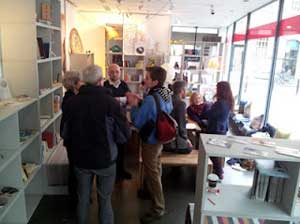
That was enjoyable – a lunchtime conversation about the city and how we can design systems and services which unlock or enable rather than curb or control.
The week’s events are being run by PIVOT Dublin, an loose gathering that brings together the four Dublin Local Authorities and others to ensure that design issues are given a decent airing. They’re taking place down in the Filmbase building down on the Curved Street in Temple Bar.
Here’s some notes that I used for my contribution:
1. Knowledge is power. Let’s spread the knowledge through transparency and openness:
Years ago a copy of the Dublin City Council Yearbook and Diary was crucial to effecting change. Once you had a copy of it you knew who was in charge of particular parts of the City Council and how to contact them. These days we use the web, but many Local Authority websites are just awful, starting with Dublin City Council. The general public simply want to know who does what, and how to contact them. We need a simple organogram for the Council that gives us the name, contact details and the responsibilities of the key players. It should be simple and clear, visible on the home page of the Council, and updated regularly.
The Dublinked site is a good start, but we need to go much further. Once we know who does what we then need to make all the information available. When Bloomberg was mayor of New York he said:
“If you can’t measure it, you can’t manage it” and I tend to agree. Every public authority, be it Dublin City Council or the OPW should put every land holding that they control up on the web in an open-source format so that we can start to think about what public lands and property (that’s your land and our land) should, or could be used for. Think about that huge site between Smithfield and the Four Courts that’s lain vacant for fifteen years. It could be a city farm, or allotments. The All-Ireland Research Observatory (AIRO) is doing some of this kind of work, and widgets like FixmyStreet.ie will also be useful, but we could go so much further in involving citizens in the future of their city.
2. Our democratic power structures need to change from the top down
I’m a city boy and I believe cities deserve more powers. Dublin was badly divided twenty years ago into Fingal, Dublin South, the City and Dún Laoghaire Rathdown. That doesn’t reflect real city. A city of a million people, or closer to two needs a voice. The four Dublin Councils need to be divided into smaller Councils that have a more coherent civic identity, around about ten in all. We need a metro-Mayor and a a Dublin Metropolitan Assembly to make teh strategic decisions for the entire metropolitan region. Instead of four councils we need closer to ten. We need to give the Mayor powers of transport and planning at Regional level. Currently we have revolving-door members in each Council every year. That means in five years we get twenty different mayors for Dublin. That can’t be right. We need one mayor who serves a five year term, and if you don’t like what she does, kicker her out. Look at the experience of Pasqual Maragall in Barcelona, Georges Frêche in Montpelier or Rahm Emanuel Chicago. Strong and vibrant cities have great mayors.
3. Make decisions based on evidence, and involve the public:
Let’s place power at the appropriate levels. In some cases we need to devolve down and in others we need to regionalise up. Big city problems like water, waste, energy and transport need a regional focus. For Urban village issues like new parks and playgrounds, taming the traffic, civic spaces and libraries let’s let a new Clontarf or Dundrum Council make the call.
Back in 1969 American Sociologist Sherry Arnstein came up with the idea of the a ladder structure to measure the degree of citizen participation in decision making. The eight rungs look like this:
- Manipulation
- Therapy
- Informing
- Consultation
- Placation
- Partnership
- Delegated power
- Citizen control
Most of the time in Ireland we’re at 1 or 2 on the ladder. On a good day we get to 3. We need to find our way to 6, 7 and 8. It’s time that we moved on. Planning can be done on a collaborative basis at a local level using Local Area Plans that we can all buy into. Let’s give some power down and see what happens. Electronic involvement is a useful tool, but don’t let it take over. I’d still like to see a notice board with an agenda on the railings outside City Hall. Collaborative structures that harness the energy of the Occupy movement, of the Irish idea of meitheal point to better ways to involve everyone in decisions.
We had a great discussion this lunchtime, ably chaired by Ré Dubhtaigh. Evelyn Hannon from Dublin City Council argued that the Council provides the theatre, but we all have to put on the play. It was a good metaphor for the role of citizens in their city.
Re-Forming our systems isn’t easy, it requires courage and conviction from those in power. In the last Government the legislation providing for directed mayors almost became a reality. Let’s try and ensure that Phil Hogan delivers on a directly elected mayor for Dublin, and a radical shake-up for our current system of local government which currently often divides rather than unites communities.





